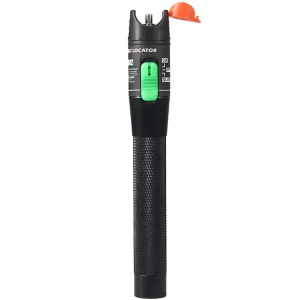Visual Fault Locator
KSh 2,000.00 N/A
What Is a Visual Fault Locator?
A Visual Fault Locator is a simple yet powerful tool used to find faults in fiber optic cables. It sends a strong red laser through the fiber, making breaks or bends easy to see. Since these faults often cause signal loss, quick detection is essential.
Moreover, this tool helps technicians locate problems without needing advanced testing equipment. Because it’s handheld and easy to use, it’s perfect for fieldwork or lab use. In fact, many network engineers rely on it during routine cable checks.
Although it’s not meant for detailed testing, it provides fast, visual confirmation of issues. Therefore, it’s an important part of any fiber optic tool kit.
Why Use a Visual Fault Locator?
When maintaining fiber optic networks, it’s important to find and fix problems quickly. A Visual Fault Locator lets you do that with ease. Because it gives instant feedback, you can pinpoint trouble spots in seconds.
Additionally, the red laser travels through the fiber and shines out at the break. As a result, you can see exactly where the issue is. Unlike more complex tools, this device works without setup time or software.
You can also use it to check continuity, which ensures your fiber is connected from end to end. For short-range testing, this method is fast, accurate, and reliable.
Key Features of the Visual Fault Locator
The Visual Fault Locator offers several helpful features for professional use. First of all, it uses a powerful red laser with high visibility, even in bright lighting. Because of this, it works well both indoors and outdoors.
Secondly, it is designed to fit in your hand, which makes it easy to carry. Most models come with a rugged case, so they’re built to last. In fact, some even have shock-resistant shells for added durability.
Moreover, the device supports both 2.5mm and 1.25mm connectors, making it compatible with a wide range of fiber cables. This adds flexibility, especially for field engineers working with different systems.
Also, the tool includes both continuous and flashing modes. This helps make breaks easier to spot, depending on the situation. Lastly, many units come with low battery indicators, so you know when it’s time to recharge or replace the battery.
Where to Use a Visual Fault Locator
You can use a Visual Fault Locator in many situations. For example, it’s perfect for FTTH installations, where cables often run through walls and tight spaces. Because of this, the laser helps you avoid damaging or misrouting cables during setup.
Also, it’s useful in data centers or telecom rooms, where many cables are installed close together. The tool helps you confirm connections without unplugging anything. As a result, it saves time and reduces risk.
In educational labs and training centers, it’s used to teach students how to inspect and troubleshoot fiber networks. Even for home users who want to test their own fiber links, this device offers simple and effective results.
How to Use a Visual Fault Locator
Using a Visual Fault Locator is quick and easy. First, connect the fiber cable to the device using the correct adapter. Next, turn on the laser by switching to continuous or flashing mode. Then, inspect the length of the cable to look for light leaks.
If the red light shines out through the jacket, you’ve found a break or bend. After locating the fault, you can repair or replace the cable. Because the process is simple, you don’t need advanced training.
However, always follow safety steps. Never point the laser at your eyes, and always use a proper cap when the device is not in use.
Benefits of Using a Visual Fault Locator
There are many benefits to using a Visual Fault Locator. First, it helps reduce downtime by quickly finding faults. Secondly, it saves money by preventing guesswork and reducing labor time.
Also, it improves accuracy during cable installs. Instead of relying on signal tests alone, you can confirm results visually. This builds confidence and ensures better network performance.
Because the tool is reusable and long-lasting, it provides great value over time. With proper care, one device can serve your team for years.
Choosing the Right Visual Fault Locator
When picking a Visual Fault Locator, consider the laser range. Most units work up to 5km or 10km, which is enough for standard tasks. Also, look at battery life and connector type support.
Some models come with belt clips or carry cases, which make them easier to bring on-site. In addition, durable designs and good grip help avoid drops or slips.
Since safety is important, make sure the unit meets laser safety standards, such as Class II or Class IIIA. These ratings tell you how strong the beam is and how to handle it safely.
Conclusion
In summary, the Visual Fault Locator is a must-have tool for any fiber optic technician. It finds cable breaks fast, checks continuity, and supports quick repairs. Because it’s easy to use and works right away, it’s ideal for both experts and beginners.
Whether you’re working in a large data center or a small home install, this device brings speed and accuracy to your job. With strong build quality and flexible features, it’s a smart investment for reliable network testing.

Visual Fault locator






Reviews
There are no reviews yet.